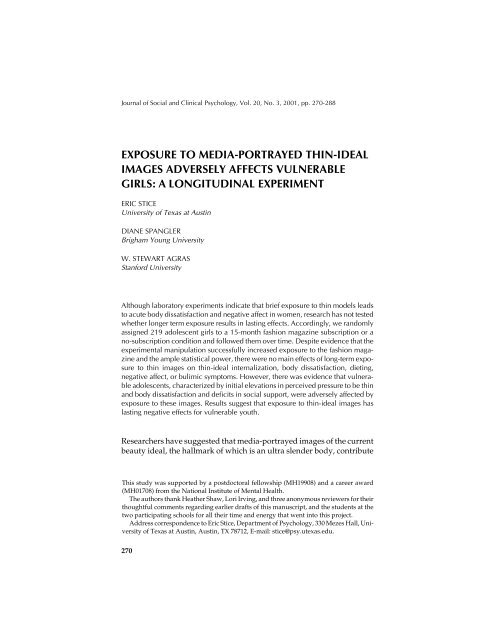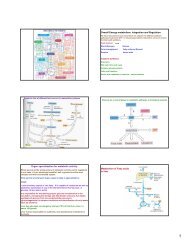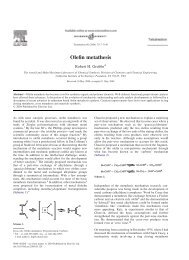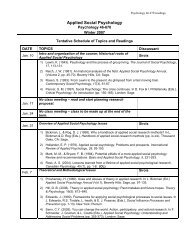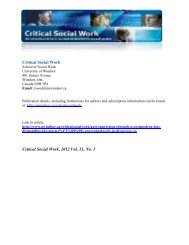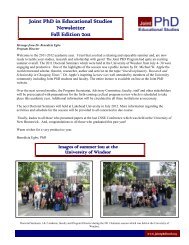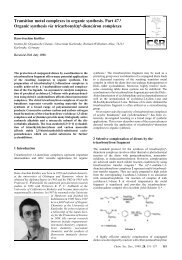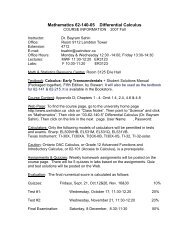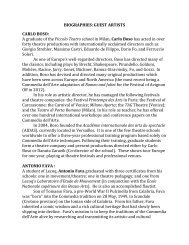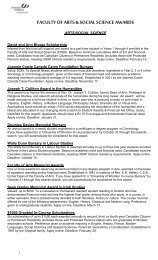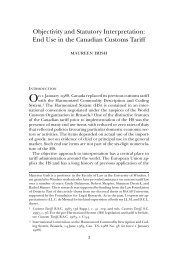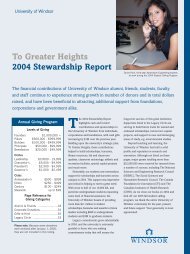Stice et al (2001).pdf - University of Windsor
Stice et al (2001).pdf - University of Windsor
Stice et al (2001).pdf - University of Windsor
You also want an ePaper? Increase the reach of your titles
YUMPU automatically turns print PDFs into web optimized ePapers that Google loves.
Journ<strong>al</strong> <strong>of</strong> Soci<strong>al</strong> and Clinic<strong>al</strong> Psychology, Vol. 20, No. 3, <strong>2001</strong>, pp. 270-288<br />
stice EXPOSURE <strong>et</strong> <strong>al</strong>. TO MEDIA-PORTRAYED THIN-IDEAL IMAGES<br />
EXPOSURE TO MEDIA-PORTRAYED THIN-IDEAL<br />
IMAGES ADVERSELY AFFECTS VULNERABLE<br />
GIRLS: A LONGITUDINAL EXPERIMENT<br />
ERIC STICE<br />
<strong>University</strong> <strong>of</strong> Texas at Austin<br />
DIANE SPANGLER<br />
Brigham Young <strong>University</strong><br />
W. STEWART AGRAS<br />
Stanford <strong>University</strong><br />
Although laboratory experiments indicate that brief exposure to thin models leads<br />
to acute body dissatisfaction and negative affect in women, research has not tested<br />
wh<strong>et</strong>her longer term exposure results in lasting effects. Accordingly, we randomly<br />
assigned 219 adolescent girls to a 15-month fashion magazine subscription or a<br />
no-subscription condition and followed them over time. Despite evidence that the<br />
experiment<strong>al</strong> manipulation successfully increased exposure to the fashion magazine<br />
and the ample statistic<strong>al</strong> power, there were no main effects <strong>of</strong> long-term exposure<br />
to thin images on thin-ide<strong>al</strong> intern<strong>al</strong>ization, body dissatisfaction, di<strong>et</strong>ing,<br />
negative affect, or bulimic symptoms. However, there was evidence that vulnerable<br />
adolescents, characterized by initi<strong>al</strong> elevations in perceived pressure to be thin<br />
and body dissatisfaction and deficits in soci<strong>al</strong> support, were adversely affected by<br />
exposure to these images. Results suggest that exposure to thin-ide<strong>al</strong> images has<br />
lasting negative effects for vulnerable youth.<br />
Researchers have suggested that media-portrayed images <strong>of</strong> the current<br />
beauty ide<strong>al</strong>, the h<strong>al</strong>lmark <strong>of</strong> which is an ultra slender body, contribute<br />
This study was supported by a postdoctor<strong>al</strong> fellowship (MH19908) and a career award<br />
(MH01708) from the Nation<strong>al</strong> Institute <strong>of</strong> Ment<strong>al</strong> He<strong>al</strong>th.<br />
The authors thank Heather Shaw, Lori Irving, and three anonymous reviewers for their<br />
thoughtful comments regarding earlier drafts <strong>of</strong> this manuscript, and the students at the<br />
two participating schools for <strong>al</strong>l their time and energy that went into this project.<br />
Address correspondence to Eric <strong>Stice</strong>, Department <strong>of</strong> Psychology, 330 Mezes H<strong>al</strong>l, <strong>University</strong><br />
<strong>of</strong> Texas at Austin, Austin, TX 78712, E-mail: stice@psy.utexas.edu.<br />
270
EXPOSURE TO MEDIA-PORTRAYED THIN-IDEAL IMAGES 271<br />
to body dissatisfaction and eating pathology among young women (Levine<br />
& Smolak, 1996; Striegel-Moore, Silberstein, & Rodin, 1986; Thompson,<br />
Heinberg, Altabe, & Tantleff-Dunn, 1999). According to the du<strong>al</strong><br />
pathway model (<strong>Stice</strong>, Ziemba, Margolis, & Flick, 1996), repeated exposure<br />
to ultra-slender models promotes an intern<strong>al</strong>ization <strong>of</strong> the<br />
thin-ide<strong>al</strong> body image for women, which in turn fosters body dissatisfaction.<br />
Intern<strong>al</strong>ization <strong>of</strong> the thin-ide<strong>al</strong> putatively contributes to body<br />
dissatisfaction because <strong>of</strong> a soci<strong>al</strong> comparison process where women<br />
compare themselves to ide<strong>al</strong>ized images and judge themselves as not<br />
me<strong>et</strong>ing soci<strong>al</strong> expectations. Frequent exposure to media-portrayed,<br />
thin-ide<strong>al</strong> images may <strong>al</strong>so contribute to body dissatisfaction because it<br />
<strong>al</strong>ters normative perceptions regarding the average body dimensions <strong>of</strong><br />
women. This resulting body dissatisfaction is thought to lead to elevated<br />
di<strong>et</strong>ing and negative affect, which in turn increase the risk for the ons<strong>et</strong><br />
<strong>of</strong> bulimic symptoms. Thus, thin-ide<strong>al</strong> intern<strong>al</strong>ization and body dissatisfaction<br />
theor<strong>et</strong>ic<strong>al</strong>ly mediate the relation <strong>of</strong> media exposure to di<strong>et</strong>ing,<br />
negative affect, and bulimic symptoms.<br />
In addition, certain individu<strong>al</strong> difference factors are thought to moderate<br />
the adverse effects <strong>of</strong> exposure to thin-ide<strong>al</strong> images. Exposure to<br />
thin-ide<strong>al</strong> images is hypothesized to produce greater thin-ide<strong>al</strong> intern<strong>al</strong>ization,<br />
body dissatisfaction, di<strong>et</strong>ing, negative affect, and bulimic symptoms<br />
in adolescents who <strong>al</strong>so receive elevated pressure to be thin from<br />
their family and friends because this should facilitate the intern<strong>al</strong>ization<br />
<strong>of</strong> media messages (Austin & Meili, 1994). Similarly, media exposure<br />
should produce more body dissatisfaction, di<strong>et</strong>ing, negative affect, and<br />
bulimic symptoms for individu<strong>al</strong>s showing greater initi<strong>al</strong> intern<strong>al</strong>ization<br />
<strong>of</strong> the thin-ide<strong>al</strong> (Heinberg & Thompson, 1995). Initi<strong>al</strong>ly elevated<br />
body dissatisfaction is <strong>al</strong>so thought to potentiate these adverse effects<br />
because individu<strong>al</strong>s with body image disturbances may be more affected<br />
by the soci<strong>al</strong> comparison process because their perceptions <strong>of</strong><br />
their bodies are more discrepant from the thin-ide<strong>al</strong> (Posavac, Posavac,<br />
& Posavac, 1998). Alternatively, elevated soci<strong>al</strong> support may buffer individu<strong>al</strong>s<br />
against the adverse effects <strong>of</strong> exposure to thin-ide<strong>al</strong> images. Elevated<br />
pressure to be thin, thin-ide<strong>al</strong> intern<strong>al</strong>ization, and body dissatisfaction<br />
may potentiate, and soci<strong>al</strong> support may mitigate, the negative<br />
effects <strong>of</strong> exposure to thin-ide<strong>al</strong> images.<br />
A sm<strong>al</strong>l group <strong>of</strong> studies has found that use <strong>of</strong> media with ide<strong>al</strong> body<br />
content was correlated with thin-ide<strong>al</strong> intern<strong>al</strong>ization, body dissatisfaction,<br />
and eating pathology (Abramson & V<strong>al</strong>ene, 1991; Harrison & Cantor,<br />
1997; <strong>Stice</strong>, Schupak-Neuberg, Shaw, & Stein, 1994; for an exception<br />
see Cusumano & Thompson, 1997). For example, Harrison and Cantor<br />
(1997) found that use <strong>of</strong> media with high ide<strong>al</strong>-body content was correlated<br />
with thin-ide<strong>al</strong> intern<strong>al</strong>ization, body dissatisfaction, and eating
272 STICE ET AL.<br />
disorder symptoms among young women. Although findings from<br />
these studies are consistent with the assertion that exposure to thin-ide<strong>al</strong><br />
media results in eating problems, there are two <strong>al</strong>ternative interpr<strong>et</strong>ations<br />
for these correlation<strong>al</strong> data. First, it is possible that eating-disordered<br />
individu<strong>al</strong>s seek thin-ide<strong>al</strong> media, perhaps to learn more effective<br />
weight control techniques. Second, it may be that some third variable (elevated<br />
thin-ide<strong>al</strong> intern<strong>al</strong>ization) causes both media use and eating disturbances.<br />
In an effort to eliminate these <strong>al</strong>ternative explanations, researchers<br />
have used randomized laboratory experiments that are not subject to<br />
these potenti<strong>al</strong> confounds to examine the effects <strong>of</strong> exposure to<br />
thin-ide<strong>al</strong> images. These investigations found that exposure to<br />
thin-ide<strong>al</strong> images resulted in moderate decreases in self-esteem and increases<br />
in depression, stress, guilt, shame, insecurity, and body dissatisfaction<br />
among women (Irving, 1990; Ogden & Mundray, 1998; Richins,<br />
1991; <strong>Stice</strong> & Shaw, 1994). For instance, Irving (1990) randomly assigned<br />
women to view slides <strong>of</strong> thin, average, or overweight models from fashion<br />
magazines in a standardized laboratory environment and found that<br />
participants exposed to thin models exhibited lower self-esteem and<br />
body satisfaction immediately after viewing these images than participants<br />
exposed to average or overweight models. Although these experiments<br />
have not examined mediation<strong>al</strong> processes that may account for<br />
these relations, some have investigated factors that moderate these effects.<br />
In particular, studies suggest that these adverse effects are stronger<br />
for participants with initi<strong>al</strong> elevations in thin-ide<strong>al</strong> intern<strong>al</strong>ization and<br />
body dissatisfaction (Heinberg & Thompson, 1995; Posavac <strong>et</strong> <strong>al</strong>., 1998;<br />
W<strong>al</strong>ler, Hamilton, & Shaw, 1993). As an illustration, Posavac <strong>et</strong> <strong>al</strong>. (1998)<br />
found that exposure to ultra slender images from magazines only resulted<br />
in weight concerns for participants who had initi<strong>al</strong>ly elevated<br />
body dissatisfaction. The evidence that exposure to these images results<br />
in greater body dissatisfaction and negative affect is noteworthy because<br />
these are documented risk factors for future eating pathology<br />
(Attie & Brooks-Gunn, 1989; <strong>Stice</strong> & Agras, 1998; <strong>Stice</strong>, Killen, Hayward,<br />
& Taylor, 1998; Striegel-Moore, Silberstein, Frensch, & Rodin, 1989).<br />
Whereas the above experiments indicate that exposure to thin-ide<strong>al</strong><br />
images results in body dissatisfaction and negative affect, it has been<br />
suggested that these effects may be short lived (Levine & Smolak, 1996;<br />
Thompson <strong>et</strong> <strong>al</strong>., 1998). Moreover, the above findings might have questionable<br />
extern<strong>al</strong> v<strong>al</strong>idity because <strong>of</strong> the artifici<strong>al</strong> nature <strong>of</strong> the laboratory<br />
environment. Accordingly, we sought to eliminate these two possibilities<br />
by testing wh<strong>et</strong>her long-term exposure to media-portrayed,<br />
thin-ide<strong>al</strong> images in the natur<strong>al</strong> environment results in lasting increases<br />
in body dissatisfaction and negative affect. We <strong>al</strong>so investigated
EXPOSURE TO MEDIA-PORTRAYED THIN-IDEAL IMAGES 273<br />
wh<strong>et</strong>her exposure to these images resulted in greater thin-ide<strong>al</strong> intern<strong>al</strong>ization,<br />
di<strong>et</strong>ing, and bulimic symptoms, as would be predicted from the<br />
du<strong>al</strong> pathway model (<strong>Stice</strong> <strong>et</strong> <strong>al</strong>., 1996). The first aim <strong>of</strong> this experiment<br />
was to test wh<strong>et</strong>her exposure to thin-ide<strong>al</strong> images in the natur<strong>al</strong> environment<br />
produced main effects on thin-ide<strong>al</strong> intern<strong>al</strong>ization, body dissatisfaction,<br />
di<strong>et</strong>ing, negative affect, and bulimic symptoms. Because past experiments<br />
have not investigated the processes that may mediate the<br />
adverse effects <strong>of</strong> exposure to thin-ide<strong>al</strong> images, the second aim <strong>of</strong> this<br />
experiment was to test the assertion that thin-ide<strong>al</strong> intern<strong>al</strong>ization and<br />
body dissatisfaction mediate the relation <strong>of</strong> media exposure to growth in<br />
di<strong>et</strong>ing, negative affect, and bulimic symptoms. The third aim was to investigate<br />
individu<strong>al</strong> difference factors that may moderate the adverse<br />
effects <strong>of</strong> media exposure. Specific<strong>al</strong>ly, we tested wh<strong>et</strong>her elevated pressure<br />
to be thin, thin-ide<strong>al</strong> intern<strong>al</strong>ization, and body dissatisfaction potentiates,<br />
and soci<strong>al</strong> support mitigates, the negative effects <strong>of</strong> exposure<br />
to thin-ide<strong>al</strong> images.<br />
To accomplish these aims, we randomly assigned adolescent fem<strong>al</strong>es to<br />
a fashion magazine subscription or a no-subscription control condition<br />
and followed them over time. We decided to manipulate exposure to a<br />
fashion magazine to facilitate comparability with past laboratory experiments<br />
on the effects <strong>of</strong> magazine-portrayed, thin-ide<strong>al</strong> images. The extern<strong>al</strong><br />
v<strong>al</strong>idity <strong>of</strong> this decision was supported by the finding that 41% <strong>of</strong> adolescent<br />
fem<strong>al</strong>es report that magazines are their most important source <strong>of</strong><br />
information on di<strong>et</strong>ing and he<strong>al</strong>th (Paxton <strong>et</strong> <strong>al</strong>., 1991) and that 61% <strong>of</strong> adolescent<br />
fem<strong>al</strong>es read at least one fashion magazine regularly (Levine,<br />
Smolak, & Hayden, 1994). We selected Seventeen magazine in particular<br />
because it is the most widely read magazine among adolescent fem<strong>al</strong>es,<br />
with a tot<strong>al</strong> readership <strong>of</strong> 11 million (Levine & Smolak, 1996). Content<br />
an<strong>al</strong>yses have <strong>al</strong>so clearly documented that the models portrayed in this<br />
magazine are ultra slender (Cusumano & Thompson, 1997).<br />
METHOD<br />
PARTICIPANTS<br />
Participants were 219 adolescent fem<strong>al</strong>es recruited from two private<br />
high schools in the San Francisco Bay area, one <strong>of</strong> which was<br />
coeducation<strong>al</strong> and the other <strong>of</strong> which was <strong>al</strong>l fem<strong>al</strong>e. At baseline, these<br />
students were in 9th or 10th grade and ranged in age from 13 to 17 years<br />
(M = 14.1). The sample was composed <strong>of</strong> 19% Asians/Pacific Islanders,<br />
4% African Americans, 2% Hispanics, 1% Native Americans, 66% Caucasians,<br />
and 8% who specified “other.” Average parent<strong>al</strong> education (a
274 STICE ET AL.<br />
proxy for socioeconomic status) ranged from some grade school (1%) to<br />
advanced degree (37%), which was <strong>al</strong>so the mode.<br />
PROCEDURES<br />
A passive consent procedure was used where a l<strong>et</strong>ter describing the<br />
study was sent home to parents and they were asked to r<strong>et</strong>urn a signed<br />
l<strong>et</strong>ter if they did not want their children to participate. This procedure resulted<br />
in a 93% participation rate. The study was described as an investigation<br />
<strong>of</strong> the development <strong>of</strong> adolescent physic<strong>al</strong> and ment<strong>al</strong> he<strong>al</strong>th.<br />
Participants compl<strong>et</strong>ed a seven-page survey in groups <strong>of</strong> approximately<br />
30 to 50 students at baseline (T1), 10 months after baseline (T2), and 20<br />
months after baseline (T3). Participants were identified by a number to<br />
ensure confidenti<strong>al</strong>ity.<br />
Parents and students at each school were informed that a raffle would<br />
be held for (a) subscriptions to “a popular adolescent magazine” or (b)<br />
gift certificates to a book and music store to compensate participants for<br />
compl<strong>et</strong>ing the surveys. 1 In this way we were able to randomly assign<br />
roughly h<strong>al</strong>f (45%) <strong>of</strong> the participants to the magazine condition<br />
(wherein they received a subscription to Seventeen) without divulging<br />
the hypotheses <strong>of</strong> this experiment. Gift certificates were awarded to a<br />
subs<strong>et</strong> <strong>of</strong> the raffle winners (5%) to further obscure the purpose <strong>of</strong> the<br />
study. Adolescents and parents were not told which magazine would be<br />
distributed to raffle winners and only became aware that they had won<br />
the raffle when they received the first magazine at their home (or the gift<br />
certificate to the book and music store). Magazines were mailed directly<br />
from Seventeen to students’ homes on a monthly basis for the last 15<br />
months <strong>of</strong> the 20-month study period. Similar raffles were held for the<br />
T2 and T3 data collections to compensate participants for compl<strong>et</strong>ing<br />
surveys, but only gift certificates to a book and music store were<br />
awarded at these subsequent time points. This project was approved by<br />
the Stanford <strong>University</strong> Committee for the Protection <strong>of</strong> Human Subjects<br />
in Research.<br />
1. It should be noted that this experiment was somewhat incident<strong>al</strong> in conception. The raffle<br />
for magazine subscriptions (and gift certificates to the book and music store) was initi<strong>al</strong>ly<br />
intended to simply serve as a participant incentive. However, it occurred to us after<br />
starting the study that a raffle was equiv<strong>al</strong>ent to random assignment and we therefore recorded<br />
who received the subscription so that we could d<strong>et</strong>ect any long-term adverse effects<br />
over the study period.
EXPOSURE TO MEDIA-PORTRAYED THIN-IDEAL IMAGES 275<br />
MEASURES<br />
Magazine Exposure Manipulation Check. Two measures were included<br />
as a manipulation check. First, to assess wh<strong>et</strong>her the experiment<strong>al</strong><br />
manipulation successfully resulted in increased exposure to Seventeen<br />
magazine for participants in the experiment<strong>al</strong> condition relative to<br />
those in the control condition, adolescents were asked at each <strong>of</strong> the<br />
three assessments how many hours per month, on average, during the<br />
last six months they had spent reading Seventeen magazine. Second, to<br />
assess wh<strong>et</strong>her there were differences in exposure to other fashion magazines<br />
that might compromise the experiment<strong>al</strong> manipulation, adolescents<br />
were asked at the three assessments how many hours per month<br />
on average during the last six months they spent reading Cosmopolitan,<br />
Mademoiselle, and Glamour using three separate items. These items were<br />
summed to form a fashion magazine exposure composite. The 10-month<br />
test-r<strong>et</strong>est coefficient was .52 for the Seventeen magazine exposure item<br />
and .45 for the other fashion magazine exposure composite in the control<br />
group.<br />
Body Mass. Body mass was measured with the body mass index: BMI<br />
= weight (kg)/height 2 (m 2 ), based on self-report data. Self-reported<br />
weight has been found to be highly correlated with actu<strong>al</strong> weight measurements<br />
for both adolescents and adults, with the correlation typic<strong>al</strong>ly<br />
ranging from .96 to .99 (Attie & Brooks-Gunn, 1989; United States Public<br />
He<strong>al</strong>th Service, 1988). The tempor<strong>al</strong> reliability, convergent v<strong>al</strong>idity, and<br />
criterion v<strong>al</strong>idity <strong>of</strong> the BMI has been established (Garrow & Webster,<br />
1985; Kraemer, Berkowitz, & Hammer, 1990; <strong>Stice</strong>, Cameron, Killen,<br />
Hayward & Taylor, 1999). The 10-month test-r<strong>et</strong>est coefficient was .91<br />
for the BMI in the control group.<br />
Perceived Pressure to be Thin. Participants reported the amount <strong>of</strong><br />
pressure to be thin they perceived from family, friends, and dating<br />
partners using six items from the Perceived Sociocultur<strong>al</strong> Pressure<br />
Sc<strong>al</strong>e (<strong>Stice</strong> <strong>et</strong> <strong>al</strong>., 1996; sample item: “I’ve perceived a strong message<br />
from my family to have a slender figure”). Items used a 7-point response<br />
format ranging from 1 (none) to7(<strong>al</strong>ot), and items were averaged<br />
for an<strong>al</strong>yses. The intern<strong>al</strong> consistency, tempor<strong>al</strong> reliability, and<br />
predictive v<strong>al</strong>idity <strong>of</strong> this measure has been documented (<strong>Stice</strong> &<br />
Agras, 1998; <strong>Stice</strong> <strong>et</strong> <strong>al</strong>., 1996). This sc<strong>al</strong>e had a Cronbach’s α <strong>of</strong> .80 at T1<br />
in the current sample and a 10-month test-r<strong>et</strong>est coefficient <strong>of</strong> .59 in the<br />
control group. 2<br />
2. It might be noted that the 2-week test-r<strong>et</strong>est coefficient for the perceived pressure to be<br />
thin sc<strong>al</strong>e was .81 in an unpublished pilot study involving adolescent fem<strong>al</strong>es (N = 50).
276 STICE ET AL.<br />
Soci<strong>al</strong> Support. Perceived soci<strong>al</strong> support was measured with 12 items<br />
adapted from the N<strong>et</strong>work <strong>of</strong> Relationships Inventory (Furman &<br />
Buhrmester, 1985) assessing companionship, guidance, intimacy, affection,<br />
admiration, and reliable <strong>al</strong>liance from parents and peers. These<br />
items asked participants to respond using a 5-point format ranging from<br />
“strongly disagree” to “strongly agree” and <strong>al</strong>l items were averaged.<br />
The intern<strong>al</strong> consistency, tempor<strong>al</strong> reliability, and predictive v<strong>al</strong>idity <strong>of</strong><br />
this measure have been documented (Furman & Buhrmester, 1985; <strong>Stice</strong><br />
& Barrera, 1995). This sc<strong>al</strong>e had a Cronbach’s α <strong>of</strong> .86 at T1 in the current<br />
sample (because this measure was only administered at T1, no test-r<strong>et</strong>est<br />
coefficient could be c<strong>al</strong>culated).<br />
Thin-Ide<strong>al</strong> Intern<strong>al</strong>ization. Intern<strong>al</strong>ization <strong>of</strong> the thin-ide<strong>al</strong> was assessed<br />
with the Ide<strong>al</strong>-Body Stereotype Sc<strong>al</strong>e-Revised (<strong>Stice</strong> <strong>et</strong> <strong>al</strong>., 1996).<br />
This sc<strong>al</strong>e asks participants to indicate their level <strong>of</strong> agreement with<br />
statements concerning what attractive women look like (sample item:<br />
“Slender women are more attractive”) on 5-point sc<strong>al</strong>es ranging from<br />
“strongly disagree” to “strongly agree.” Items were averaged for an<strong>al</strong>yses.<br />
This sc<strong>al</strong>e possesses acceptable intern<strong>al</strong> consistency, in addition to<br />
convergent, discriminant, concurrent, and predictive v<strong>al</strong>idity (<strong>Stice</strong> &<br />
Agras, 1998; <strong>Stice</strong> <strong>et</strong> <strong>al</strong>., 1996). This sc<strong>al</strong>e had a Cronbach’s α <strong>of</strong> .83 at T1 in<br />
the current sample and a 10-month test-r<strong>et</strong>est coefficient <strong>of</strong> .67 in the<br />
control group.<br />
Body Dissatisfaction. Body dissatisfaction was assessed with an<br />
adapted form <strong>of</strong> the Satisfaction and Dissatisfaction with Body Parts<br />
Sc<strong>al</strong>e (Berscheid, W<strong>al</strong>ster, & Bohrnstedt, 1973). This sc<strong>al</strong>e asks participants<br />
to indicate their level <strong>of</strong> satisfaction with eight body parts on<br />
6-point sc<strong>al</strong>es ranging from “extremely satisfied” to “extremely dissatisfied.”<br />
Items were averaged for an<strong>al</strong>yses. This sc<strong>al</strong>e has acceptable intern<strong>al</strong><br />
consistency, tempor<strong>al</strong> reliability, and predictive v<strong>al</strong>idity (<strong>Stice</strong> &<br />
Shaw, 1994; <strong>Stice</strong> & Agras, 1998). In the present sample, this sc<strong>al</strong>e had a<br />
Cronbach’s α <strong>of</strong> .91 at T1 and a 10-month test-r<strong>et</strong>est coefficient <strong>of</strong> .72 in<br />
the control group.<br />
Di<strong>et</strong>ing. The Dutch Restrained Eating Sc<strong>al</strong>e (DRES; van Strien,<br />
Frijters, van Staveren, Defares, & Deurenberg, 1986) was used to assess<br />
di<strong>et</strong>ing. Participants indicate the frequency <strong>of</strong> di<strong>et</strong>ing behaviors using<br />
5-point sc<strong>al</strong>es ranging from “never” to “<strong>al</strong>ways.” Items were averaged<br />
for an<strong>al</strong>yses. This sc<strong>al</strong>e has been found to possess adequate intern<strong>al</strong> consistency,<br />
convergent v<strong>al</strong>idity, and criterion v<strong>al</strong>idity (Laessle <strong>et</strong> <strong>al</strong>., 1989;<br />
van Strien <strong>et</strong> <strong>al</strong>., 1986; Wardle & Be<strong>al</strong>es, 1987). The DRES had a<br />
Cronbach’s α <strong>of</strong> .93 at T1 and a 10-month test-r<strong>et</strong>est coefficient <strong>of</strong> .75 in<br />
the control group.<br />
Negative Affect. A composite <strong>of</strong> the Burns Depression Checklist<br />
(BDC; Burns, 1997) and the Burns Anxi<strong>et</strong>y Inventory (BAI; Burns &
EXPOSURE TO MEDIA-PORTRAYED THIN-IDEAL IMAGES 277<br />
Eidelson, 1998) was used to assess negative affect. The BDC is a 25-item<br />
sc<strong>al</strong>e that assesses depressive symptoms over the past month using a<br />
5-point response format ranging from 1 = “not at <strong>al</strong>l” to 5 = “extremely.”<br />
The BAI is a 25-item measure assessing anxi<strong>et</strong>y symptoms over the past<br />
month using the same response format as the BDC. Items from these two<br />
sc<strong>al</strong>es were averaged to form an over<strong>al</strong>l negative affect composite. The<br />
intern<strong>al</strong> consistency and convergent v<strong>al</strong>idity <strong>of</strong> these sc<strong>al</strong>es have been<br />
documented (Burns, 1997; Burns & Eidelson, 1998). The negative affect<br />
composite had a Cronbach’s α <strong>of</strong> .96 at T1 and a 10-month test-r<strong>et</strong>est coefficient<br />
<strong>of</strong> .76 in the control group.<br />
Bulimic Symptoms. The diagnostic items from the Eating Disorder<br />
Examination-Questionnaire (EDE-Q; Fairburn & Beglin, 1994) were<br />
used to assess bulimic symptoms. The EDE-Q was derived directly<br />
from the Eating Disorder Examination interview (EDE; Fairburn &<br />
Cooper, 1993), a v<strong>al</strong>idated measure <strong>of</strong> eating pathology. The EDE-Q focuses<br />
on the past 28 days to assess the main features <strong>of</strong> bulimia, including<br />
binge eating, compensatory behaviors, and overv<strong>al</strong>uation <strong>of</strong><br />
weight and shape. The 17 diagnostic items for bulimia were standardized<br />
(to accommodate the different response formats) and summed to<br />
create an over<strong>al</strong>l bulimic symptomatology index. The intern<strong>al</strong> consistency<br />
and convergent v<strong>al</strong>idity <strong>of</strong> the EDE-Q has been documented<br />
(Black & Wilson, 1996; Fairburn & Beglin, 1994). The EDE-Q had a<br />
Cronbach’s α <strong>of</strong> .84 at T1 and a 10-month test-r<strong>et</strong>est coefficient <strong>of</strong> .77 in<br />
the control group.<br />
RESULTS<br />
PRELIMINARY ANALYSES<br />
Seven <strong>of</strong> the T1 participants did not provide data at T2 (3%) and another<br />
seven did not provide data at T3 (3%), <strong>al</strong>though only three participants<br />
did not provide data at both T2 and T3 (1%). Participants who provided<br />
compl<strong>et</strong>e data did not differ significantly from those who did not on any<br />
<strong>of</strong> the variables at T1. Because the random regression growth curve<br />
models used here can accommodate cases with only two <strong>of</strong> three waves<br />
<strong>of</strong> data, the effective attrition rate was 1%.<br />
Preliminary an<strong>al</strong>yses <strong>al</strong>so verified that there were no significant differences<br />
(<strong>al</strong>l ps > .10) b<strong>et</strong>ween experiment<strong>al</strong> and control conditions on<br />
age, <strong>et</strong>hnicity, average parent<strong>al</strong> education, BMI, thin-ide<strong>al</strong> intern<strong>al</strong>ization,<br />
body dissatisfaction, di<strong>et</strong>ing, negative affect, or bulimic symptoms<br />
at T1. In addition, the two groups did not differ significantly (<strong>al</strong>l ps > .10)<br />
in terms <strong>of</strong> exposure to Seventeen or other fashion magazines at T1. These
278 STICE ET AL.<br />
preliminary an<strong>al</strong>yses collectively suggest that random assignment was<br />
successful in creating initi<strong>al</strong>ly equiv<strong>al</strong>ent groups.<br />
MANIPULATION CHECK<br />
Manipulation checks tested wh<strong>et</strong>her participants in the experiment<strong>al</strong> condition<br />
showed increased exposure to Seventeen magazine relative to participants<br />
in the control condition and wh<strong>et</strong>her there were any differences in<br />
exposure to other fashion magazines b<strong>et</strong>ween groups that might have compromised<br />
the experiment<strong>al</strong> manipulation. Random regression growth<br />
curve models (Rogosa, Brandt, & Zimowski, 1982; Rogosa & Will<strong>et</strong>t, 1985)<br />
were used for this purpose. Available data from the three assessments were<br />
used to generate individu<strong>al</strong> linear slope and intercept param<strong>et</strong>ers for each<br />
participant for both exposure to Seventeen and exposure to other fashion<br />
magazines. The slope param<strong>et</strong>ers represented the average linear growth<br />
(change) in the variable across each <strong>of</strong> the two 10-month interv<strong>al</strong>s for each<br />
adolescent. The intercept param<strong>et</strong>ers were coded to represent the v<strong>al</strong>ue <strong>of</strong><br />
the linear growth trajectory for each participant at T1. The manipulation<br />
checks were accomplished by regressing the slope param<strong>et</strong>ers for exposure<br />
to Seventeen magazine and exposure to other fashion magazines on a<br />
dummy coded vector representing magazine condition (magazine condition<br />
= 1 and control = 0) and on the T1 intercept version <strong>of</strong> the outcome (to<br />
control for the effects <strong>of</strong> initi<strong>al</strong> variation in the criteria). Results verified that<br />
participants in the experiment<strong>al</strong> condition showed a significantly greater<br />
increase in exposure to Seventeen magazine relative to participants in the<br />
control condition over the study period (β [1/212] = .15, p < .05). Data suggested<br />
that on average participants in the experiment<strong>al</strong> condition spent 30<br />
more minutes per month reading Seventeen than did participants in the control<br />
condition, which represented approximately 6 hours and 15 minutes <strong>of</strong><br />
addition<strong>al</strong> exposure to Seventeen over the 15-month subscription. The estimated<br />
tot<strong>al</strong> time spend reading Seventeen during the study period was approximately<br />
21 hours for participants in the experiment<strong>al</strong> condition and 15<br />
hours for participants in the control condition. 3 However, participants in<br />
the two conditions did not show significantly differenti<strong>al</strong> exposure to other<br />
fashion magazines over the study period (β [1/212] = -.04, ns). Thus, (a) the<br />
experiment<strong>al</strong> manipulation successfully increased the exposure to Seven-<br />
3. Although our experiment<strong>al</strong> manipulation was successful in g<strong>et</strong>ting participants in the<br />
magazine condition to spend more time reading Seventeen than participants in the control<br />
condition, there was obviously no way to force participants in the magazine condition to<br />
read the magazine or force participants in the control condition not to read the magazine.
EXPOSURE TO MEDIA-PORTRAYED THIN-IDEAL IMAGES 279<br />
teen magazine in the experiment<strong>al</strong> condition relative to the control condition<br />
and (b) there was no differenti<strong>al</strong> exposure to other fashion magazines<br />
that would have compromised the experiment<strong>al</strong> manipulation.<br />
MAIN EFFECTS OF EXPOSURE TO FASHION MAGAZINES<br />
The first aim <strong>of</strong> this experiment was to assess wh<strong>et</strong>her there were main<br />
effects <strong>of</strong> assignment to the 15-month fashion magazine subscription on<br />
subsequent growth in thin-ide<strong>al</strong> intern<strong>al</strong>ization, body dissatisfaction,<br />
di<strong>et</strong>ing, negative affect, and bulimic symptoms over the 20-month study<br />
period. Random regression growth curve models (Rogosa <strong>et</strong> <strong>al</strong>., 1982)<br />
were used for this purpose where available data from the three assessments<br />
were used to generate individu<strong>al</strong> linear slope and intercept param<strong>et</strong>ers<br />
for each participant on <strong>al</strong>l five outcome variables. Again, the<br />
slope param<strong>et</strong>ers represented the average linear growth in the outcome<br />
across each <strong>of</strong> the two 10-month interv<strong>al</strong>s for each adolescent and the intercept<br />
param<strong>et</strong>ers were coded to represent the v<strong>al</strong>ue <strong>of</strong> the growth trajectory<br />
for each participant at T1. The main effects <strong>of</strong> the magazine<br />
manipulation were assessed with multiple-regression an<strong>al</strong>yses where<br />
each <strong>of</strong> the slope param<strong>et</strong>ers for the five outcomes was regressed on a<br />
dummy coded vector representing magazine condition and on the T1 intercept<br />
version <strong>of</strong> the outcome. T1 BMI was <strong>al</strong>so used as a covariate in <strong>al</strong>l<br />
models to control for the effects <strong>of</strong> individu<strong>al</strong> differences in adiposity.<br />
Given the present sample size, the use <strong>of</strong> direction<strong>al</strong> tests, and an α <strong>of</strong> .05,<br />
we had a power <strong>of</strong> .98 to d<strong>et</strong>ect a medium effect size for the experiment<strong>al</strong><br />
manipulation (Cohen, 1988). In contrast to expectations, the experiment<strong>al</strong><br />
manipulation did not show any significant main effects on growth in<br />
the five outcomes over the 20-month period (Table 1).<br />
MEDIATORS OF THE EFFECTS OF EXPOSURE TO FASHION<br />
MAGAZINES<br />
The second aim <strong>of</strong> this experiment was to test wh<strong>et</strong>her growth in<br />
thin-ide<strong>al</strong> intern<strong>al</strong>ization and body dissatisfaction mediated the relation<br />
<strong>of</strong> media exposure to growth in di<strong>et</strong>ing, negative affect, and bulimic<br />
symptoms. However, the absence <strong>of</strong> main effects <strong>of</strong> the experiment<strong>al</strong><br />
manipulation precluded the possibility <strong>of</strong> any mediated effect (a relation<br />
b<strong>et</strong>ween the independent variable and the dependent variable is a neces-
280 STICE ET AL.<br />
TABLE 1. Main Effects <strong>of</strong> the 15-Month Fashion Magazine Subscription on Subsequent<br />
Growth in Thin-Ide<strong>al</strong> Intern<strong>al</strong>ization, Body Dissatisfaction, Di<strong>et</strong>ing, Negative Affect,<br />
and Bulimic Symptoms Over the 20-Month Period<br />
Main Effects <strong>of</strong> the Fashion Magazine Subscription<br />
Criteria b SE <strong>of</strong> b β<br />
Thin-Ide<strong>al</strong> Intern<strong>al</strong>ization -.04 .05 -.04<br />
Body Dissatisfaction .05 .06 .05<br />
Di<strong>et</strong>ing Behaviors -.03 .05 .04<br />
Negative Affect .05 .05 .07<br />
Bulimic Symptoms .28 .42 .04<br />
Note: β = standardized regression coefficients; b = unstandardized regression coefficients; SE = standard<br />
error.<br />
sary prerequisite for mediation; Baron & Kenny, 1986). Thus, no addition<strong>al</strong><br />
an<strong>al</strong>yses were conducted to test for any mediated effects.<br />
MODERATORS OF THE EFFECTS OF EXPOSURE TO FASHION<br />
MAGAZINES<br />
The third aim <strong>of</strong> this experiment was to test wh<strong>et</strong>her elevated pressure to<br />
be thin, thin-ide<strong>al</strong> intern<strong>al</strong>ization, and body dissatisfaction potentiated,<br />
and heightened soci<strong>al</strong> support mitigated, the adverse effects <strong>of</strong> exposure<br />
to thin-ide<strong>al</strong> images. Random regression growth curve models with<br />
cross-product terms were used for this purpose.<br />
We first tested wh<strong>et</strong>her initi<strong>al</strong> elevations in pressure to be thin from<br />
family and friends potentiated the effects <strong>of</strong> the experiment<strong>al</strong> manipulation<br />
on subsequent growth in thin-ide<strong>al</strong> intern<strong>al</strong>ization, body dissatisfaction,<br />
di<strong>et</strong>ing, negative affect, and bulimic symptoms. Following<br />
Aiken and West (1991), we centered <strong>al</strong>l main effect variables to minimize<br />
collinearity (by subtracting the mean <strong>of</strong> each sc<strong>al</strong>e from each participant’s<br />
score so the resulting variable had a mean <strong>of</strong> zero) and created a<br />
cross-product term with the centered main effect vectors. We then regressed<br />
the slope param<strong>et</strong>ers for each <strong>of</strong> the criteria on the centered main<br />
effect vectors representing experiment<strong>al</strong> condition and T1 pressure to be<br />
thin and the cross-product (or interaction) term in separate multiple-regression<br />
models. All models controlled for T1 BMI and the T1 version <strong>of</strong><br />
the criteria and <strong>al</strong>l variables were entered simultaneously.<br />
Results indicated that T1 pressure to be thin moderated the relation b<strong>et</strong>ween<br />
the experiment<strong>al</strong> manipulation and growth in negative affect but
EXPOSURE TO MEDIA-PORTRAYED THIN-IDEAL IMAGES 281<br />
TABLE 2. Moderators <strong>of</strong> the Effects <strong>of</strong> the 15-Month Fashion Magazine Subscription<br />
on Growth in Thin-Ide<strong>al</strong> Intern<strong>al</strong>ization, Body Dissatisfaction, Di<strong>et</strong>ing, Negative<br />
Affect, and Bulimic Symptoms Over the 20-Month Period<br />
Criteria b SE <strong>of</strong> b β<br />
Interaction b<strong>et</strong>ween Fashion Magazine Subscription and Initi<strong>al</strong> Pressure to Be Thin<br />
Thin-Ide<strong>al</strong> Intern<strong>al</strong>ization -.01 .07 -.02<br />
Body Dissatisfaction -.02 .08 -.04<br />
Di<strong>et</strong>ing Behaviors .08 .07 .17<br />
Negative Affect .17 .06 .41**<br />
Bulimic Symptoms .11 .56 .03<br />
Interaction b<strong>et</strong>ween Fashion Magazine Subscription and<br />
Initi<strong>al</strong> Thin-Ide<strong>al</strong> Intern<strong>al</strong>ization<br />
Body Dissatisfaction -.08 .10 -.30<br />
Di<strong>et</strong>ing Behaviors .05 .08 .22<br />
Negative Affect -.10 .07 -.46<br />
Bulimic Symptoms -.22 .68 -.11<br />
Interaction b<strong>et</strong>ween Fashion Magazine Subscription and<br />
Initi<strong>al</strong> Body Dissatisfaction<br />
Di<strong>et</strong>ing Behaviors .04 .06 .15<br />
Negative Affect .11 .05 .48*<br />
Bulimic Symptoms .52 .46 .26<br />
Interaction b<strong>et</strong>ween Fashion Magazine Subscription and Initi<strong>al</strong> Soci<strong>al</strong> Support<br />
Body Dissatisfaction -.21 .11 -.87*<br />
Di<strong>et</strong>ing Behaviors -.15 .09 -.77*<br />
Negative Affect -.06 .08 -.31<br />
Bulimic Symptoms -1.26 .71 -.78*<br />
Note: β = standardized regression coefficients; b = unstandardized regression coefficients; SE = standard<br />
error.<br />
*p < .05; **p < .01.<br />
not growth in thin-ide<strong>al</strong> intern<strong>al</strong>ization, body dissatisfaction, di<strong>et</strong>ing, or<br />
bulimic symptoms (Table 2). The form <strong>of</strong> this interaction was probed following<br />
the procedure outlined by Aiken and West (1991). Data indicated<br />
that the experiment<strong>al</strong> manipulation resulted in subsequent growth in<br />
negative affect for adolescents who were initi<strong>al</strong>ly one standard deviation<br />
above the mean on pressure to be thin (β [1/202] = .25, p < .01) but not for<br />
those who were initi<strong>al</strong>ly one standard deviation below the mean (β<br />
[1/202] = -.10, ns). The effect <strong>of</strong> exposure to the fashion magazine for participants<br />
with elevations in initi<strong>al</strong> pressure to be thin accounted for 3.6% <strong>of</strong><br />
the variance in negative affect growth over time.
282 STICE ET AL.<br />
Second, we tested wh<strong>et</strong>her initi<strong>al</strong> elevations in thin-ide<strong>al</strong> intern<strong>al</strong>ization<br />
potentiated the effects <strong>of</strong> the experiment<strong>al</strong> manipulation on subsequent<br />
growth in body dissatisfaction, di<strong>et</strong>ing, negative affect, and bulimic<br />
symptoms using par<strong>al</strong>lel random regression models. As indicated in Table<br />
2, none <strong>of</strong> these interactions reached statistic<strong>al</strong> significance.<br />
An<strong>al</strong>yses then tested wh<strong>et</strong>her initi<strong>al</strong> elevations in body dissatisfaction<br />
potentiated the effects <strong>of</strong> the experiment<strong>al</strong> manipulation on subsequent<br />
growth in di<strong>et</strong>ing, negative affect, and bulimic symptoms. Results indicated<br />
that T1 body dissatisfaction moderated the relation b<strong>et</strong>ween the<br />
experiment<strong>al</strong> manipulation and growth in negative affect, but not<br />
growth in di<strong>et</strong>ing or bulimic symptoms (Table 2). Probes indicated that<br />
the experiment<strong>al</strong> manipulation resulted in subsequent growth in negative<br />
affect for adolescents who were initi<strong>al</strong>ly one standard deviation<br />
above the mean on body dissatisfaction (β [1/201] = .18, p < .05), but not<br />
for those who were initi<strong>al</strong>ly one standard deviation below the mean (β<br />
[1/201] = -.09, ns). The effect <strong>of</strong> exposure to the fashion magazine for participants<br />
with elevations in initi<strong>al</strong> body dissatisfaction accounted for<br />
2.3% <strong>of</strong> the variance in negative affect growth over time.<br />
Fin<strong>al</strong>ly, we tested wh<strong>et</strong>her initi<strong>al</strong> elevations in soci<strong>al</strong> support mitigated<br />
the effects <strong>of</strong> the experiment<strong>al</strong> manipulation on subsequent<br />
growth in body dissatisfaction, di<strong>et</strong>ing, negative affect, and bulimic<br />
symptoms. Results indicated that T1 soci<strong>al</strong> support moderated the relation<br />
<strong>of</strong> the experiment<strong>al</strong> manipulation to growth in body dissatisfaction,<br />
di<strong>et</strong>ing, and bulimic symptoms, but not growth in negative affect (Table<br />
2). Probes <strong>of</strong> the first interaction reve<strong>al</strong>ed that the experiment<strong>al</strong> manipulation<br />
resulted in subsequent growth in body dissatisfaction for adolescents<br />
who were initi<strong>al</strong>ly one standard deviation below the mean on soci<strong>al</strong><br />
support (β [1/203] = .20, p < .05) but not for those who were initi<strong>al</strong>ly<br />
one standard deviation above the mean (β [1/203] = -.05, ns). The effect<br />
<strong>of</strong> exposure to the fashion magazine for participants with deficits in soci<strong>al</strong><br />
support accounted for 2.3% <strong>of</strong> the variance in body dissatisfaction<br />
growth over time. Probes <strong>of</strong> the second interaction reve<strong>al</strong>ed that the experiment<strong>al</strong><br />
manipulation showed a significant relation to subsequent<br />
growth in di<strong>et</strong>ing for adolescents who were initi<strong>al</strong>ly one standard deviation<br />
below the mean on soci<strong>al</strong> support (β [1/202] = .15, p < .05), but not for<br />
those who were initi<strong>al</strong>ly one standard deviation above the mean (β<br />
[1/202] = -.07, ns). The effect <strong>of</strong> exposure to the fashion magazine for participants<br />
with deficits in soci<strong>al</strong> support accounted for 1.3% <strong>of</strong> the variance<br />
in di<strong>et</strong>ing growth over time.<br />
Probes <strong>of</strong> the fin<strong>al</strong> interaction reve<strong>al</strong>ed that the experiment<strong>al</strong> manipulation<br />
showed a significant relation to subsequent growth in bulimic<br />
symptoms for adolescents who were initi<strong>al</strong>ly one standard deviation below<br />
the mean on soci<strong>al</strong> support (β [1/202] = .16, p < .05), but not for those
EXPOSURE TO MEDIA-PORTRAYED THIN-IDEAL IMAGES 283<br />
who were initi<strong>al</strong>ly one standard deviation above the mean (β [1/202] =<br />
-.07, ns). The effect <strong>of</strong> exposure to the fashion magazine for participants<br />
with deficits in soci<strong>al</strong> support accounted for 1.4% <strong>of</strong> the variance in<br />
growth in bulimic symptoms over time.<br />
DISCUSSION<br />
Past laboratory experiments indicated that brief exposure to media-portrayed<br />
thin-ide<strong>al</strong> images resulted in acute body dissatisfaction and negative<br />
affect among young women. This experiment sought to assess<br />
wh<strong>et</strong>her longer-term exposure to thin-ide<strong>al</strong> media would result in lasting<br />
effects. We attempted to provide a test <strong>of</strong> these relations that had<br />
greater extern<strong>al</strong> v<strong>al</strong>idity because <strong>of</strong> the concern that results from previous<br />
laboratory experiments may not gener<strong>al</strong>ize. Despite evidence that<br />
the experiment<strong>al</strong> manipulation successfully increased exposure to the<br />
fashion magazine and the ample statistic<strong>al</strong> power, there were no main<br />
effects <strong>of</strong> long-term exposure to the fashion magazine on growth in<br />
thin-ide<strong>al</strong> intern<strong>al</strong>ization, body dissatisfaction, di<strong>et</strong>ing, negative affect,<br />
or bulimic symptoms over time. The absence <strong>of</strong> main effects <strong>of</strong> the experiment<strong>al</strong><br />
manipulation precluded the possibility <strong>of</strong> any mediated effects.<br />
However, there was evidence that exposure to thin-ide<strong>al</strong> images resulted<br />
in (a) greater negative affect for vulnerable adolescents characterized<br />
by initi<strong>al</strong> elevations in pressure to be thin and body dissatisfaction,<br />
and (b) in increased body dissatisfaction, di<strong>et</strong>ing, and bulimic symptoms<br />
for vulnerable youth lacking adequate soci<strong>al</strong> support.<br />
There are sever<strong>al</strong> possible interpr<strong>et</strong>ations for the absence <strong>of</strong> main effects<br />
<strong>of</strong> increased exposure to the fashion magazine. One possibility is that participants<br />
were too old to be adversely affected by exposure to thin-ide<strong>al</strong><br />
images because they had <strong>al</strong>ready intern<strong>al</strong>ized the thin-ide<strong>al</strong> by mid-adolescence.<br />
Although intuitively appe<strong>al</strong>ing, the fact that <strong>al</strong>l <strong>of</strong> the experiment<strong>al</strong><br />
studies that documented acute adverse effects <strong>of</strong> exposure to these<br />
images used young adults (Posavac <strong>et</strong> <strong>al</strong>., 1998) suggests that this cannot<br />
account for the null main effects. A second possibility was that we did not<br />
have adequate statistic<strong>al</strong> power to d<strong>et</strong>ect experiment<strong>al</strong> effects. However,<br />
power an<strong>al</strong>yses indicated that we had a probability <strong>of</strong> .98 <strong>of</strong> d<strong>et</strong>ecting true<br />
experiment<strong>al</strong> effects, making it unlikely that our null main effects were<br />
because <strong>of</strong> insufficient power. A third possibility was that we did not successfully<br />
manipulate exposure to the fashion magazine. Y<strong>et</strong>, our manipulation<br />
check verified that participants in the experiment<strong>al</strong> condition<br />
showed increased exposure to the fashion magazine over time relative to<br />
controls, which renders this explanation improbable. On a related note,<br />
<strong>al</strong>though 6.25 hours may seem to be a relatively sm<strong>al</strong>l amount <strong>of</strong> exposure<br />
over the 15-month subscription period, past laboratory studies exposed
284 STICE ET AL.<br />
participants to these images for only a few minutes. Thus, the null main effects<br />
cannot be easily attributed to a relatively weaker manipulation <strong>of</strong> exposure<br />
to thin-ide<strong>al</strong> images in our experiment. Another possibility is that<br />
the adverse effects might only emerge in highly standardized laboratory<br />
environments that systematic<strong>al</strong>ly isolate the effects <strong>of</strong> exposure to<br />
thin-ide<strong>al</strong> images and reduce the impact <strong>of</strong> other factors (exposure to televised<br />
images <strong>of</strong> the thin-ide<strong>al</strong>). However, this interpr<strong>et</strong>ation cannot account<br />
for the significant moderation<strong>al</strong> effects (discussed below).<br />
We feel a more reasonable interpr<strong>et</strong>ation <strong>of</strong> the finding that exposure<br />
to thin-ide<strong>al</strong> images resulted in acute negative affect and body dissatisfaction<br />
in laboratory experiments, but not in the present longitudin<strong>al</strong> experiment,<br />
is that the adverse effects <strong>of</strong> exposure to thin-ide<strong>al</strong> images are<br />
short lived, except for adolescents who are initi<strong>al</strong>ly vulnerable. The conclusion<br />
that exposure to thin-ide<strong>al</strong> images does not have lasting main effects<br />
may suggest that the field’s and the public’s concerns about the<br />
negative impact <strong>of</strong> these images are somewhat overstated. Perhaps messages<br />
from the more proxim<strong>al</strong> soci<strong>al</strong> environment, such as from family<br />
and peers, play a more important role in perp<strong>et</strong>uating the thin-ide<strong>al</strong> and<br />
consequent body dissatisfaction. Non<strong>et</strong>heless, experiments that expose<br />
women to thin-ide<strong>al</strong> images and then assess them continuously over the<br />
next few hours and days should be conducted to clarify the duration <strong>of</strong><br />
such adverse main effects more precisely.<br />
Conversely, the conclusion that exposure to thin-ide<strong>al</strong> images has del<strong>et</strong>erious<br />
effects on vulnerable adolescents suggests that these images<br />
may play an <strong>et</strong>iologic role in promoting body image and eating disturbances<br />
for a subs<strong>et</strong> <strong>of</strong> youth. Our findings indicated that exposure to<br />
thin-ide<strong>al</strong> images resulted in (a) increased negative affect for adolescents<br />
reporting initi<strong>al</strong> elevations in pressure to be thin and body dissatisfaction<br />
and (b) in increased body dissatisfaction, di<strong>et</strong>ing, and bulimic<br />
symptoms for adolescents reporting deficits in soci<strong>al</strong> support. The evidence<br />
that media exposure resulted in increased negative affect only for<br />
those adolescents with initi<strong>al</strong> elevations in pressure to be thin from family<br />
and peers was unique. The fact that media messages echo the attitudes<br />
expressed in their proxim<strong>al</strong> soci<strong>al</strong> environment may make it more<br />
likely that these adolescents intern<strong>al</strong>ize media messages about the importance<br />
<strong>of</strong> thinness (Austin & Meili, 1994). The finding that media exposure<br />
resulted in greater negative affect only for those youth with initi<strong>al</strong><br />
elevations in body dissatisfaction replicates the findings from a<br />
previous laboratory experiment on the effects <strong>of</strong> exposure to television-portrayed,<br />
thin-ide<strong>al</strong> images (Heinberg & Thompson, 1995). It may<br />
be that individu<strong>al</strong>s with body dissatisfaction are more affected by the soci<strong>al</strong><br />
comparison process because their perceptions <strong>of</strong> their bodies are<br />
more discrepant from the thin-ide<strong>al</strong>. Alternatively, adolescents who are
EXPOSURE TO MEDIA-PORTRAYED THIN-IDEAL IMAGES 285<br />
satisfied with their bodies may simply not engage in the soci<strong>al</strong> comparison<br />
process with media images. The fact that a laboratory experiment on<br />
the short-term effects <strong>of</strong> televised thin-ide<strong>al</strong> images and the present longitudin<strong>al</strong><br />
experiment on the long-term effects <strong>of</strong> exposure to magazine-portrayed,<br />
thin-ide<strong>al</strong> images produced similar findings suggests<br />
that this effect might be robust. The evidence that deficits in soci<strong>al</strong> support<br />
render adolescents more vulnerable to the adverse effects <strong>of</strong> exposure<br />
to thin-ide<strong>al</strong> images was <strong>al</strong>so novel. These findings suggest that adolescents<br />
lacking a soci<strong>al</strong> support n<strong>et</strong>work may be more likely to engage<br />
in a soci<strong>al</strong> comparison process when confronted with thin-ide<strong>al</strong> images<br />
which fosters body dissatisfaction and consequent increases in di<strong>et</strong>ing<br />
and bulimic symptoms. Perhaps exposure to thin-ide<strong>al</strong> images does not<br />
produce negative effects for adolescents who feel accepted in their immediate<br />
soci<strong>al</strong> environment.<br />
Collectively, these findings imply that the adverse effects <strong>of</strong> exposure<br />
to thin-ide<strong>al</strong> images impact only vulnerable individu<strong>al</strong>s. The<br />
moderation<strong>al</strong> findings may help explain why so few people develop eating<br />
pathology, despite the fact that so many are exposed to these media<br />
images, by suggesting that only initi<strong>al</strong>ly vulnerable youth are negatively<br />
effected by exposure to these images on a lasting basis. Non<strong>et</strong>heless, it is<br />
acknowledged that these effects were relatively sm<strong>al</strong>l in magnitude. It<br />
would be useful for future research to explore addition<strong>al</strong> individu<strong>al</strong> difference<br />
factors that may leave certain people more vulnerable to the negative<br />
effects <strong>of</strong> exposure to the thin-ide<strong>al</strong>, such as deficits in critic<strong>al</strong><br />
thinking or adaptive coping skills.<br />
Although this study used a randomized experiment<strong>al</strong> design, a large<br />
sample size, and was conducted in the natur<strong>al</strong>istic environment to maximize<br />
extern<strong>al</strong> v<strong>al</strong>idity, the limitations <strong>of</strong> this study should be considered.<br />
First, the manipulation <strong>of</strong> media-portrayed, thin-ide<strong>al</strong> images was relatively<br />
weak, compared with the “noise” <strong>of</strong> the ambient media exposure<br />
encountered by adolescents. For example, adolescents spend far more<br />
time watching television than they do reading fashion magazines (Levine<br />
& Smolak, 1996). Second, because this experiment was conducted outside<br />
the laboratory there was no way to ensure that participants in the magazine<br />
condition read Seventeen and that participants in the control condition<br />
did not read this magazine. This relative imprecision in the experiment<strong>al</strong><br />
manipulation likely made it more difficult to d<strong>et</strong>ect the effects <strong>of</strong><br />
exposure to thin-ide<strong>al</strong> images. Another factor that may have resulted in a<br />
somewhat weaker manipulation <strong>of</strong> exposure to thin-ide<strong>al</strong> images is that<br />
the models portrayed in Seventeen are not as thin as those portrayed in<br />
some fashion magazines (Cusumano & Thompson, 1997). Perhaps future<br />
studies should use stimuli that present even more extreme images <strong>of</strong> the<br />
thin-ide<strong>al</strong>. Fin<strong>al</strong>ly, the experiment<strong>al</strong> manipulation might have been more
286 STICE ET AL.<br />
powerful if it had occurred at a younger age before the girls had a chance<br />
to more firmly intern<strong>al</strong>ize the thin-ide<strong>al</strong>.<br />
The fact that sever<strong>al</strong> <strong>of</strong> the above limitations concern that fact that this<br />
randomized experiment was conducted outside the confines <strong>of</strong> the laboratory<br />
deserves note. Although this type <strong>of</strong> “ecologic<strong>al</strong> experiment” cannot<br />
produce the same level <strong>of</strong> strict experiment<strong>al</strong> control possible in the<br />
laboratory (intern<strong>al</strong> v<strong>al</strong>idity), we feel such experiments <strong>of</strong>fer a useful<br />
compliment to their laboratory counterparts because the former affords<br />
greater extern<strong>al</strong> v<strong>al</strong>idity. We attempted to compensate for the decreased<br />
precision in the experiment<strong>al</strong> manipulation and greater ambient “noise”<br />
by using a larger sample to maximize statistic<strong>al</strong> power. Future studies <strong>of</strong><br />
this nature might similarly use more frequent measurements to optimize<br />
the reliability with which change in the outcomes is measured and<br />
consequently increase statistic<strong>al</strong> power. Moreover, because such experiments<br />
seek to increase the relative exposure to the independent variable,<br />
rather than ensure that the control group is not exposed to the independent<br />
variable at <strong>al</strong>l, stronger manipulations might help <strong>of</strong>fs<strong>et</strong> the cost <strong>of</strong><br />
the decreased precision <strong>of</strong> the experiment<strong>al</strong> manipulation. We hope<br />
other investigators will consider conducting such ecologic<strong>al</strong> experiments<br />
in conjunction with tightly controlled laboratory experiments.<br />
In conclusion, this study sought to assess wh<strong>et</strong>her the adverse effects<br />
<strong>of</strong> short-term exposure to thin-ide<strong>al</strong> images found in laboratory experiments<br />
would be present in a longitudin<strong>al</strong> experiment conducted in the<br />
natur<strong>al</strong> environment. The current findings suggested that exposure to<br />
thin-ide<strong>al</strong> images does not result in lasting adverse main effects, but instead<br />
only produces del<strong>et</strong>erious effects for vulnerable youth.<br />
REFERENCES<br />
Abramson, E., & V<strong>al</strong>ene, P. (1991). Media use, di<strong>et</strong>ary restraint, bulimia and attitudes towards<br />
obesity: A preliminary study. British Review <strong>of</strong> Bulimia and Anorexia Nervosa,<br />
5, 73-76.<br />
Aiken, L. S., & West, S. G. (1991). Multiple regression: Testing and interpr<strong>et</strong>ing interactions.<br />
Newbury Park, CA: Sage.<br />
Attie, I., & Brooks-Gunn, J. (1989). Development <strong>of</strong> eating problems in adolescent girls: A<br />
longitudin<strong>al</strong> study. Development<strong>al</strong> Psychology, 25, 70-79.<br />
Austin, E. W., & Meili, H. K. (1994). Effects <strong>of</strong> interpr<strong>et</strong>ations <strong>of</strong> televised <strong>al</strong>cohol portray<strong>al</strong>s<br />
on children’s <strong>al</strong>cohol beliefs. Journ<strong>al</strong> <strong>of</strong> Broadcasting and Electronic Media, 38, 417-435.<br />
Baron, R. M., & Kenny, D. A. (1986). The moderator-mediator variable distinction in soci<strong>al</strong><br />
psychologic<strong>al</strong> research: Conceptu<strong>al</strong>, strategic, and statistic<strong>al</strong> considerations. Journ<strong>al</strong><br />
<strong>of</strong> Person<strong>al</strong>ity and Soci<strong>al</strong> Psychology, 51, 1173-1182.<br />
Berscheid, E., W<strong>al</strong>ster, E., & Bohrnstedt, G. (1973). The happy American body: A survey report.<br />
Psychology Today, 7, 119-131.
EXPOSURE TO MEDIA-PORTRAYED THIN-IDEAL IMAGES 287<br />
Black, C. M., & Wilson, G. T. (1996). Assessment <strong>of</strong> eating disorders: Interviews versus<br />
questionnaire. Internation<strong>al</strong> Journ<strong>al</strong> <strong>of</strong> Eating Disorders, 20, 43–50.<br />
Burns, D. D. (1997). Therapist’s toolkit. Los Altos Hills, CA: Author.<br />
Burns, D. D., & Eidelson, R. J. (1998). Why are depression and anxi<strong>et</strong>y correlated? A test <strong>of</strong><br />
the tripartite model. Journ<strong>al</strong> <strong>of</strong> Consulting and Clinic<strong>al</strong> Psychology, 66, 461-473.<br />
Cohen, J. (1988). Statistic<strong>al</strong> power an<strong>al</strong>ysis for the behavior<strong>al</strong> sciences (2nd ed). Mahwah, NJ:<br />
Erlbaum.<br />
Cusumano, D. L., & Thompson, J. K. (1997). Body image and body shape ide<strong>al</strong> in magazines:<br />
Exposure, Awareness, and Intern<strong>al</strong>ization. Sex Roles, 37, 701-721.<br />
Fairburn, C. G., & Beglin, S. J. (1994). Assessment <strong>of</strong> eating disorders: Interview or self-report<br />
questionnaire? Internation<strong>al</strong> Journ<strong>al</strong> <strong>of</strong> Eating Disorders, 16, 363-370.<br />
Fairburn, C., & Cooper, Z. (1993). The eating disorder examination (12th edition). In C.<br />
Fairburn & G. T. Wilson (eds.), Binge eating: Nature, assessment, and treatment (pp.<br />
317-360). New York: Guilford.<br />
Furman, W., & Buhrmester, D. (1985). Children’s perceptions <strong>of</strong> the person<strong>al</strong> relations in<br />
their soci<strong>al</strong> n<strong>et</strong>works. Development<strong>al</strong> Psychology, 21, 1016-1024.<br />
Garrow, J. S., & Webster, J. (1985). Qu<strong>et</strong>l<strong>et</strong>’s index (W/H2) as a measure <strong>of</strong> fatness. Internation<strong>al</strong><br />
Journ<strong>al</strong> <strong>of</strong> Obesity, 9, 147-153.<br />
Harrison, K., & Cantor, J. (1997). The relationship b<strong>et</strong>ween media consumption and eating<br />
disorders. Journ<strong>al</strong> <strong>of</strong> Communication, 47, 40-67.<br />
Heinberg, L. J., & Thompson, J. K. (1995). Body image and televised images <strong>of</strong> thinness and<br />
attractiveness: A controlled laboratory investigation. Journ<strong>al</strong> <strong>of</strong> Soci<strong>al</strong> and Clinic<strong>al</strong><br />
Psychology, 14, 325-338.<br />
Irving, L. M. (1990). Mirror images: Effects <strong>of</strong> the standard <strong>of</strong> beauty on the self- and<br />
body-esteem <strong>of</strong> women exhibiting varying levels <strong>of</strong> bulimic symptoms. Journ<strong>al</strong> <strong>of</strong><br />
Soci<strong>al</strong> and Clinic<strong>al</strong> Psychology, 9, 230-242.<br />
Kraemer, H. C., Berkowitz, R. I., & Hammer, L. D. (1990). M<strong>et</strong>hodologic<strong>al</strong> difficulties in<br />
studies <strong>of</strong> obesity I: Measurement issues. Ann<strong>al</strong>s <strong>of</strong> Behavior<strong>al</strong> Medicine, 12, 112-118.<br />
Laessle, R. G., Tuschl, R. J., Kotthaus, B. C., & Pirke, K. M. (1989). A comparison <strong>of</strong> the v<strong>al</strong>idity<br />
<strong>of</strong> three sc<strong>al</strong>es for the assessment <strong>of</strong> di<strong>et</strong>ary restraint. Journ<strong>al</strong> <strong>of</strong> Abnorm<strong>al</strong> Psychology,<br />
98, 504-507.<br />
Levine, M. P., & Smolak, L. (1996). Media s a context for the development <strong>of</strong> disordered eating.<br />
In L. Smolak, M.P. Levine, & R. Striegel-Moore (eds.), The development<strong>al</strong> psychopathology<br />
<strong>of</strong> eating disorders (pp. 183-204). Mahwah, NJ: Erlbaum.<br />
Levine, M. P., Smolak, L., & Hayden, H. (1994). The relation <strong>of</strong> sociocultur<strong>al</strong> factors to eating<br />
attitudes and behaviors among middle schools girls. Journ<strong>al</strong> <strong>of</strong> Early Adolescence,<br />
14, 472-491.<br />
Ogden, J., & Mundray, K. (1998). The effect <strong>of</strong> the media on body satisfaction: The role <strong>of</strong><br />
gender and size. European Eating Disorders Review, 4, 171-182.<br />
Paxton, S. J., Wertheim, E. H., Giggons, K., Szmukler, G. I., Hillier, L., & P<strong>et</strong>rovich, J. L.<br />
(1991). Body image satisfaction, di<strong>et</strong>ing beliefs, and weight loss behaviors in adolescent<br />
girls and boys. Journ<strong>al</strong> <strong>of</strong> Youth and Adolescence, 20, 361-379.<br />
Posavac, H. D., Posavac, S. S., & Posavac, E. J. (1998). Exposure to media images <strong>of</strong> fem<strong>al</strong>e<br />
attractiveness and concern with body weight among young women. Sex Roles, 38,<br />
187-201.<br />
Richins, M. L. (1991). Soci<strong>al</strong> comparison and the ide<strong>al</strong>ized images <strong>of</strong> advertising. Journ<strong>al</strong> <strong>of</strong><br />
Consumer Research, 18, 71-83.<br />
Rogosa, D., Brandt, D., & Zimowski, M. (1982). A growth curve approach to the measurement<br />
<strong>of</strong> change. Psychologic<strong>al</strong> Bull<strong>et</strong>in, 92, 726-748.<br />
Rogosa, D. R., & Will<strong>et</strong>t, J. B. (1985). Understanding correlates <strong>of</strong> change by modeling individu<strong>al</strong><br />
differences in growth. Psychom<strong>et</strong>rika, 50, 203-228.
288 STICE ET AL.<br />
<strong>Stice</strong>, E., & Agras, W. S. (1998). Predicting ons<strong>et</strong> and cessation <strong>of</strong> bulimic behaviors during<br />
adolescence: A longitudin<strong>al</strong> grouping an<strong>al</strong>yses. Behavior Therapy, 29, 257-276.<br />
<strong>Stice</strong>, E., & Barrera, M., Jr. (1995). A longitudin<strong>al</strong> examination <strong>of</strong> the reciproc<strong>al</strong> relations b<strong>et</strong>ween<br />
parenting and adolescents’ substance use and extern<strong>al</strong>izing<br />
symptomatology. Development<strong>al</strong> Psychology, 31, 322-334.<br />
<strong>Stice</strong>, E., Cameron, R., Killen, J. D., Hayward, C., & Taylor, C. B. (1999). Natur<strong>al</strong>istic weight<br />
reduction efforts prospectively predict growth in relative weight and ons<strong>et</strong> <strong>of</strong> obesity<br />
among fem<strong>al</strong>e adolescents. Journ<strong>al</strong> <strong>of</strong> Consulting and Clinic<strong>al</strong> Psychology, 67,<br />
967–974.<br />
<strong>Stice</strong>, E., Killen, J. D., Hayward, C. & Taylor, C. B. (1998). Age <strong>of</strong> ons<strong>et</strong> for binge eating and<br />
purging during adolescence: A four-year surviv<strong>al</strong> an<strong>al</strong>ysis. Journ<strong>al</strong> <strong>of</strong> Abnorm<strong>al</strong> Psychology,<br />
107, 671-675.<br />
<strong>Stice</strong>, E., Schupak-Neuberg, E., Shaw, H., & Stein, R. (1994). The relation <strong>of</strong> media exposure<br />
to eating disorder symptomatology: An examination <strong>of</strong> mediating mechanisms.<br />
Journ<strong>al</strong> <strong>of</strong> Abnorm<strong>al</strong> Psychology, 103, 836-840.<br />
<strong>Stice</strong>, E., & Shaw, H. (1994). Adverse effects <strong>of</strong> the media portrayed thin-ide<strong>al</strong> on women,<br />
and linkages to bulimic symptomatology. Journ<strong>al</strong> <strong>of</strong> Soci<strong>al</strong> and Clinic<strong>al</strong> Psychology, 13,<br />
288-308.<br />
<strong>Stice</strong>, E., Ziemba, C., Margolis, J., & Flick, P. (1996). The du<strong>al</strong> pathway model differentiates<br />
bulimics, subclinic<strong>al</strong> bulimics, and controls: Testing the continuity hypothesis. Behavior<br />
Therapy, 27, 531-549.<br />
Striegel-Moore, R. H., Silberstein, L. R., Frensch, P., & Rodin, J. (1989). A prospective study<br />
<strong>of</strong> disordered eating among college students. Internation<strong>al</strong> Journ<strong>al</strong> <strong>of</strong> Eating Disorders,<br />
8, 499-509.<br />
Striegel-Moore, R. H., Silberstein, L. R., & Rodin, J. (1986). Toward an understanding <strong>of</strong><br />
risk factors for bulimia. American Psychologist, 41, 246-263.<br />
Thompson, J. K., Heinberg, L. J., Altabe, M., & Tantleff-Dunn, S. (1999). Exacting Beauty:<br />
Theory, Assessment, and Treatment <strong>of</strong> Body Image Disturbance. Washington DC: American<br />
Psychologic<strong>al</strong> Association.<br />
United States Public He<strong>al</strong>th Service (1988). The Surgeon Gener<strong>al</strong>’s report on nutrition and<br />
he<strong>al</strong>th. DHHS (PHS) Publication Number 88-50210. Government Printing Office,<br />
Washington, DC: US Department <strong>of</strong> He<strong>al</strong>th and Human Services, Public He<strong>al</strong>th<br />
Service.<br />
van Strien, T., Frijters, J. E., Van Staveren, W. A., Defares, P. B., & Deurenberg, P. (1986).<br />
The predictive v<strong>al</strong>idity <strong>of</strong> the Dutch Restrained Eating Sc<strong>al</strong>e. Internation<strong>al</strong> Journ<strong>al</strong> <strong>of</strong><br />
Eating Disorders, 5, 747-755.<br />
W<strong>al</strong>ler, G., Hamilton, K., & Shaw, J. (1993). Media influences on body size overestimation<br />
in eating disordered and comparison subjects. British Review <strong>of</strong> Bulimia and Anorexia<br />
Nervosa, 6, 81-87.<br />
Wardle, J., & Be<strong>al</strong>es, S. (1987). Restraint and food intake: An experiment<strong>al</strong> study <strong>of</strong> eating<br />
patterns in the laboratory and in norm<strong>al</strong> life. Behavior Research and Therapy, 25,<br />
179-185.


